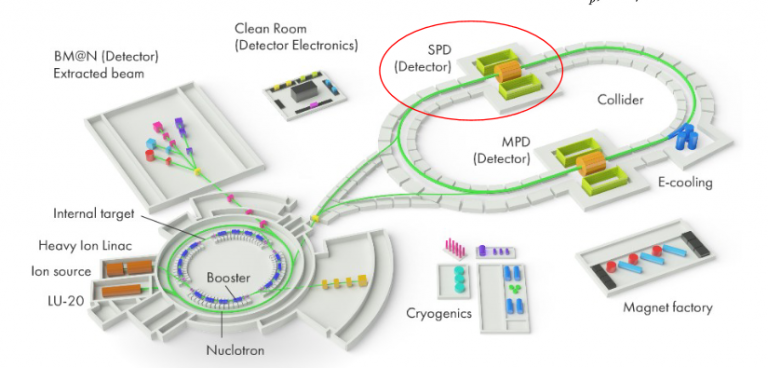
=====================================================================
The SPD experiment is aimed at studying the properties of
strong interactions in the nonperturbative region, at measuring
the proton and deuteron spin structures, and at the development
of a three-dimensional model of the nucleon.
2025 : The CVMFS system is used to store SPD software versions. As one of the NICA projects, it can take up to 4,000 cores for its jobs. EOS storage systems are used for data storage (eos.jinr.ru = 2000.00TB, eos-spd.jinr.ru = 7200TB ).
Equipment of eos-spd :
18 servers
3 controls (metadata): 4×1.5TB NVMe
2xIntel Xeon Gold 6526Y , 16 cores, HT
512GB RAM
15 disk drives: 24x20TB SAS + 2×1.5TB NVMe
2xIntel Xeon Silver 4510, 12 cores, HT
512GB RAM
100Gbps network
7.2 PB full disk capacity
24 groups of 15 discs each
11+4 QRAIN (27% redundancy)
5.3 PB of available data volume
You can lose four nodes (or disks in a group)
Data Access Protocols :
xrootd (port 1094)
http(s) (port 8000)
Authentication:
X.509 certificate from SPD IAM
JINR Kerberos (only for collaboration members with an account in SPD IAM)
JWT token from SPD IAM (disabled for now)
Administration:
SSH with a key from JINR’s internal network
Allocation of available disk space:
90% under Rucio management, as part of a distributed storage system;
10% for the data of the experiment participants, users of the civil code.
SPD Resources and Services:
• CA, VOMS/IAM, CVMFS
• Cloud (IaaS, dedicated VM, spinning disks and SSD)
• CICC (Slurm batch, grid ARC6 CE)
• Govorun HPC, HybriLIT
• Disk and tape storage (EOS physical space 2000.00TB. , grid SE)
• GitLab, Indico, docdb, video conference, project management, etc.
• MICC
Principles of the computing system
• Jobs -> tasks -> trains of tasks -> workflows
• Files -> datasets
• Collect and store metadata of each workflow/task/job, dataset/file and event
• Advanced data life management strategies: some files should be deleted immediately, others will be stored until the end of production, others will be stored for some period after collection, and the most important data should be stored forever.
• Focusing on the use of containers as a universal response to the variety of software versions in data centers: we are publishing a tagged version of SpdRoot on CVMFS so that everyone can use it.
• We mean multiprocessor, multithreaded, and non-x86 architectures of modern hardware.
— The Gaudi-based platform for SPD continues to be developed, which will replace SpdRoot based on the ROOT structure.
Production
• CVMFS as an entry point to the “official” versions of SpdRoot.
• Production sets on CVMFS in the form of frozen sandboxes
• Each new production means a new directory with all CVMFS dependencies
• Each production in CVMFS corresponds to a path with the same name in
EOS
• The role of “production” in VOMS for users launching mass production
• A directory for storing production results on EOS with strict access rights in order not to accidentally delete